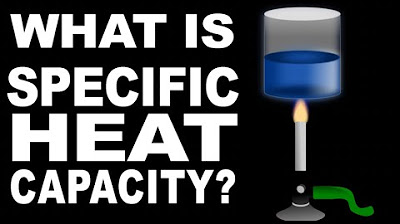GCSE Physics Revision "Required Practical 1: Specific Heat Capacity"
Summary
TLDRThis video explains a practical method for determining the specific heat capacity of a material, using vegetable oil as an example. It walks viewers through the steps of the experiment, including measuring mass, setting up the apparatus, and calculating the specific heat capacity using energy, mass, and temperature change. Common errors such as thermal energy loss and inaccurate thermometer readings are also addressed, with tips on improving accuracy. The video concludes by encouraging students to practice this required practical and use the provided resources for further study.
Takeaways
- 😀 The specific heat capacity of a substance is the amount of energy required to raise 1 kilogram of the substance by 1°C.
- 😀 The experiment focuses on determining the specific heat capacity of vegetable oil using an immersion heater and a joule meter.
- 😀 To begin, a beaker is placed on a balance, zeroed, and then filled with a known mass of vegetable oil.
- 😀 A thermometer and immersion heater are placed in the oil, and the initial temperature is recorded.
- 😀 The setup is insulated using foam to reduce heat loss to the surroundings, ensuring more accurate results.
- 😀 The immersion heater is powered for about 30 minutes while the joule meter records the electrical energy supplied.
- 😀 After 30 minutes, the final temperature of the oil is recorded, and the energy supplied by the immersion heater is noted.
- 😀 The specific heat capacity is calculated using the formula: Specific Heat Capacity = Change in Energy / (Mass x Temperature Change).
- 😀 In the example calculation, 87,258 J of energy raised 0.95 kg of oil from 20°C to 75°C, resulting in a specific heat capacity of 1,670 J/kg°C.
- 😀 Potential sources of error in the experiment include thermal energy loss to the surroundings, incomplete energy transfer, and inaccurate temperature readings.
- 😀 These errors can be minimized by improving insulation, fully submerging the immersion heater, using an electronic temperature probe, and stirring the oil to ensure uniform heating.
Q & A
What is specific heat capacity?
-Specific heat capacity is the amount of energy required to raise the temperature of 1 kilogram of a substance by 1°C.
What is the purpose of the experiment described in the video?
-The purpose of the experiment is to determine the specific heat capacity of vegetable oil by measuring the energy required to heat it and the change in temperature.
How is the mass of the vegetable oil measured in the experiment?
-The mass of the vegetable oil is measured by placing a beaker on a balance, zeroing it, adding the oil, and recording the mass displayed on the balance.
What is the role of the immersion heater in this experiment?
-The immersion heater is used to transfer electrical energy into the oil, raising its temperature. The joulemeter measures the total energy transferred to the oil.
Why is the beaker wrapped in insulating foam?
-The beaker is wrapped in insulating foam to reduce thermal energy loss to the surroundings, ensuring more accurate measurements of the oil’s temperature change.
What equipment is used to measure the change in energy transferred to the oil?
-A joulemeter is used to measure the total electrical energy (in joules) transferred into the immersion heater, which in turn heats the oil.
How is the specific heat capacity of the oil calculated?
-The specific heat capacity is calculated using the equation: Specific Heat Capacity = ΔQ / (m × ΔT), where ΔQ is the change in thermal energy, m is the mass of the oil, and ΔT is the temperature change.
What were the experimental results in the video?
-In the experiment, 0.95 kg of vegetable oil was heated from 20°C to 75°C, and 87258 joules of energy were transferred, resulting in a specific heat capacity of 1670 J/kg°C.
What are some sources of error that could affect the accuracy of the experiment?
-Possible sources of error include heat loss to the surroundings, incomplete energy transfer from the immersion heater to the oil, inaccurate thermometer readings, and uneven heat distribution in the oil.
How can the accuracy of the experiment be improved?
-The accuracy can be improved by using better insulation materials, ensuring the immersion heater is fully submerged, using electronic temperature probes, and stirring the oil to ensure uniform heating.
Outlines

هذا القسم متوفر فقط للمشتركين. يرجى الترقية للوصول إلى هذه الميزة.
قم بالترقية الآنMindmap

هذا القسم متوفر فقط للمشتركين. يرجى الترقية للوصول إلى هذه الميزة.
قم بالترقية الآنKeywords

هذا القسم متوفر فقط للمشتركين. يرجى الترقية للوصول إلى هذه الميزة.
قم بالترقية الآنHighlights

هذا القسم متوفر فقط للمشتركين. يرجى الترقية للوصول إلى هذه الميزة.
قم بالترقية الآنTranscripts

هذا القسم متوفر فقط للمشتركين. يرجى الترقية للوصول إلى هذه الميزة.
قم بالترقية الآنتصفح المزيد من مقاطع الفيديو ذات الصلة
5.0 / 5 (0 votes)






